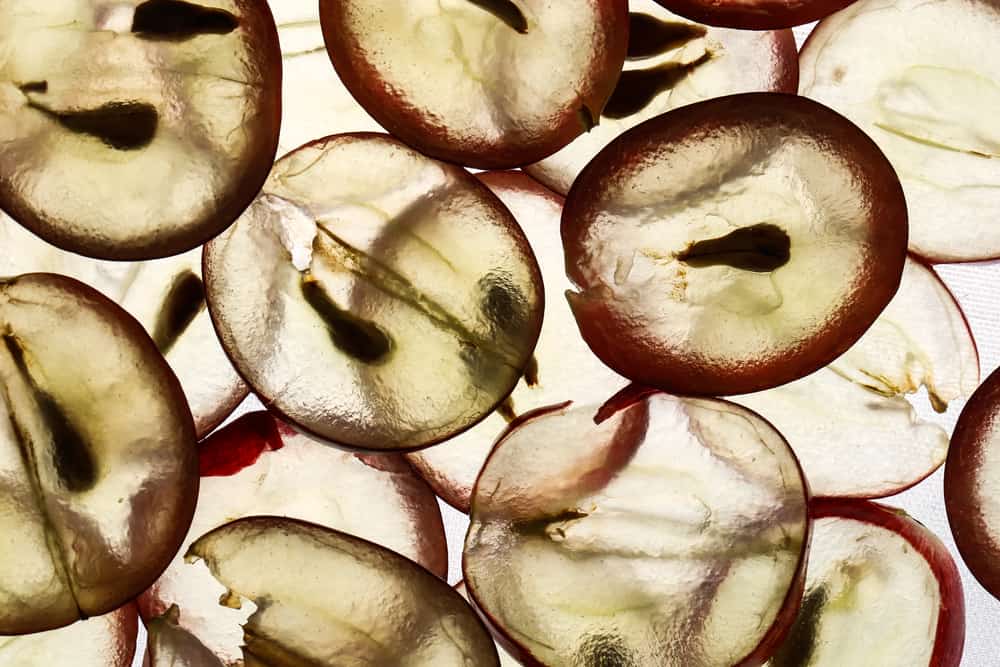Share this post
Digestive health affects the healing potential of these potent antioxidant polyphenols
Grape seed extract (GSE) by no means is new to the nutraceutical world, yet we are still unveiling the myriad of benefits from the antioxidant-like nutritional compounds found within it. We are also gaining broader knowledge of the mechanisms by which individual responses to this substance may vary. GSE has been studied for its potential use in the management of blood pressure,[1] high cholesterol and metabolic syndrome,[2],[3] stress response,[4] brain function,[5] inflammation,[6] and even cancer.[7]
GSE is high in antioxidants in the form of polyphenols, which contribute to its potential therapeutic action.[8] The most noteworthy polyphenol – and the grape’s greatest claim to fame – is resveratrol, which is found primarily in the skins of grapes. The seeds, however, are rich in the also-important polyphenols gallic acid, catechin, and epicatechin.[9] Studies have shown that some of these compounds sourced from grapes, such as catechin and epicatechin, have a synergistic antioxidant effect, meaning they work more powerfully when combined than when isolated and taken by themselves.[10] The amount of each of these substances in GSE varies widely based on the variety of grape from which the seeds are sourced.
One of the factors that plays a significant role in the absorption and bioavailability of polyphenols is the intestinal microenvironment – the enzymes present and the combination of bacteria, viruses, and fungi that inhabit the gut, collectively known as the “intestinal flora.”
The ability of the body to absorb polyphenols varies, and studies have shown that there is very little relation between the amount of polyphenols in foods and their bioavailability in human body.[11] One of the factors that plays a significant role in the absorption and bioavailability of these compounds is the intestinal microenvironment – the enzymes present and the combination of bacteria, viruses, and fungi that inhabit the gut, collectively known as the “intestinal flora.”[12] In the process of absorption, polyphenols are modified significantly in intestines and the liver by various biochemical reactions (such as methylation, sulfation and/or glucuronidation, for you biochemistry fans).[13] This processing of polyphenols creates metabolites, or intermediary products that are also absorbed, many of which possess more bioactivity than their precursors.[14] Polyphenols also affect the balance of gastrointestinal flora, an additional mechanism by which their effects may be seen.[15]
In addition to the microenvironment in the gut, a wide variety of factors have been shown to influence the efficacy of grape seed polyphenols, including gender,[16] age,[17] and even health status.[18]
Substantial differences in the metabolism and distribution of GSE-derived polyphenols have been observed between male and female animals not only in the plasma but also in the liver and the brain, the organs via which they exert their effects. It’s been proposed that differences are due to the influences of progesterone and estrogen on the uptake of flavanols (a type of polyphenol found in GSE) through the blood-brain barrier as well as differences in the activity of the enzyme catechol-o-methyltransferase (COMT) between males and females.[19],[20]
In animals with high blood pressure, oral administration of GSE was shown to lead to a significant reduction in blood pressure at 6 hours post-consumption, while it didn’t impact the blood pressure of healthy rats.
Age also has been shown to contribute to significant differences between young and older (adult) rats.[13] With increasing age, the gut microenvironment, liver and kidney function, blood volume, and metabolizing enzyme activity all may change.[21] In a gender-limited population of male rats, shortly after dosing, total flavanol concentration in plasma was found to be about three times lower in adult rats than that of the young rats. However, the older rats were shown to have much higher concentrations of GSE microbial metabolites at all time points, suggested to be because reduced absorption in the small intestine allowed more of the GSE compounds to reach the large intestine intact and available for microbiota metabolism.
Finally, health status also has been shown to impact GSE flavanol bioavailability and metabolism.[14] In rats with high blood pressure, oral administration of GSE was shown to lead to a significant reduction in blood pressure at 6 hours post-consumption, while it didn’t impact the blood pressure of healthy rats.
It is not uncommon to see such an effect in both humans and animals with a variety of nutritional supplements much like GSE: when physiology is not out of balance, a supplement will not have a significant effect, however when it is (such as being hypertensive in this setting), the effect becomes significant. At times, this may point to dietary deficiencies of said nutrient (in this case antioxidants) which may have existed that were contributing to the pathology, which when remedied, brought the body back into balance.
The more we understand the impact that our microbiota has on our health, the more this understanding opens up further study of how diet and botanically derived substances may affect us each, individually.[22] There is no doubt that studies such as this will continue to further pique our interest in further understanding of the impacts of nutritional substances on our health, and in cases such as GSE more directed application of these findings.
Click here to see References
[1] Park E, et al. Effects of grape seed extract beverage on blood pressure and metabolic indices in individuals with pre-hypertension: a randomised, double-blinded, two-arm, parallel, placebo-controlled trial. Br J Nutr. 2016 Jan 28;115(2):226-38.
[2] Sivaprakasapillai B, et al. Effect of grape seed extract on blood pressure in subjects with the metabolic syndrome. Metabolism. 2009 Dec;58(12):1743-6.
[3] Caimari A, et al. Low doses of grape seed procyanidins reduce adiposity and improve the plasma lipid profile in hamsters. Int J Obes (Lond). 2013 Apr;37(4):576-83.
[4] Sreemantula S, et al. Adaptogenic and nootropic activities of aqueous extract of Vitis vinifera (grape seed): an experimental study in rat model. BMC Complement Altern Med. 2005 Jan 19;5:1.
[5] Asha Devi S, et al. Grape seed proanthocyanidin lowers brain oxidative stress in adult and middle-aged rats. Exp Gerontol. 2011 Nov;46(11):958-64.
[6] Fujishita, K, et al. Grape seed extract acting on astrocytes reveals neuronal protection against oxidative stress via Interleukin-6-mediated mechanisms. Cell Mol Neurobiol (2009) 29: 1121.
[7] Neuwirt H, et al. Oligomeric proanthocyanidin complexes (OPC) exert anti-proliferative and pro-apoptotic effects on prostate cancer cells. Prostate. 2008 Nov 1;68(15):1647-54.
[8] Shi J, et al. Polyphenolics in grape seeds-biochemistry and functionality. J Med Food. 2003 Winter;6(4):291-9.
[9] Yilmaz Y, Toledo RT. Major flavonoids in grape seeds and skins: antioxidant capacity of catechin, epicatechin, and gallic acid. J Agric Food Chem. 2004 Jan 28;52(2):255-60.
[10] Iacopini P, et al. Catechin, epicatechin, quercetin, rutin and resveratrol in red grape: Content, in vitro antioxidant activity and interactions. Journal of Food Composition and Analysis. 2008 Dec 31;21(8):589-98.
[11] Manach C, et al. Polyphenols: food sources and bioavailability. Am J Clin Nutr. 2004 May;79(5):727-47.
[12] Pandey KB, Rizvi SI. Plant polyphenols as dietary antioxidants in human health and disease. Oxid Med Cell Longev. 2009 Nov-Dec;2(5):270-8.
[13] Day AJ, Williamson G. Biomarkers for exposure to dietary flavonoids: a review of the current evidence for identification of quercetin glycosides in plasma. Br J Nutr. 2001 Aug;86 Suppl 1:S105-10.
[14] Chiou YS, et al. Metabolic and colonic microbiota transformation may enhance the bioactivities of dietary polyphenols. J Func Foods. 2014 Mar 31;7:3-25.
[15] Ozdal T, et al. The Reciprocal Interactions between Polyphenols and Gut Microbiota and Effects on Bioaccessibility. Nutrients. 2016 Feb 6;8(2):78.
[16] Margalef M, et al. Gender-related similarities and differences in the body distribution of grape seed flavanols in rats. Mol Nutr Food Res. 2016 Apr;60(4):760-72.
[17] Margalef M, et al. Age related differences in the plasma kinetics of flavanols in rats. J Nutr Biochem. 2016 Mar;29:90-6.
[18] Margalef M, et al. Rat health status affects bioavailability, target tissue levels, and bioactivity of grape seed flavanols. Mol Nutr Food Res. 2017 Feb;61(2).
[19] Faria A, et al. Insights into the putative catechin and epicatechin transport across blood-brain barrier. Food Funct. 2011;2(1):39-44.
[20] Harrison PJ, Tunbridge EM. Catechol-O-methyltransferase (COMT): a gene contributing to sex differences in brain function, and to sexual dimorphism in the predisposition to psychiatric disorders. Neuropsychopharmacology. 2008 Dec 1;33(13):3037-45.
[21] Lee JS, et al. Coordinated changes in xenobiotic metabolizing enzyme gene expression in aging male rats. Toxicol Sci. 2008 Nov;106(1):263-83.
[22] Chen F, et al. Could the gut microbiota reconcile the oral bioavailability conundrum of traditional herbs? J Ethnopharmacol. 2016 Feb 17;179:253-64.
The information provided is for educational purposes only. Consult your physician or healthcare provider if you have specific questions before instituting any changes in your daily lifestyle including changes in diet, exercise, and supplement use.
Share this post
Dr. Carrie Decker
Related posts
Mushrooms for Whole Immune Support
The profound response of the human immune system to mushrooms Living in the Pacific Northwest, I often find myself staring up at the grey sky, wondering, “What’s good about all this rain?” As my eyes scan my surroundings and take in the lush, green foliage of the region, it doesn’t take long for the…
The Tradition of Chios Mastiha
The intangible cultural heritage of Chios mastiha (mastic) gum production Oftentimes, we take our nutritional supplements without so much as a thought to how they happen to come to the powder that fills the capsule. Others of us, who also probably are mesmerized by television shows like “How It’s Made,” the Discovery channel documentary…
Enzymes to Help with Accidental Gluten Consumption
Many products that claim to support gluten digestion might not be fully doing the job! Celiac and other types of gluten sensitivity Celiac disease (CD) is the most studied and broadly recognized disease associated with the immune reaction to gluten consumption. Celiac disease is a multifactorial disease characterized by an inflammatory response to ingested…
Big Pharma Banks on Fatty Liver Disease
Where there’s a buck to be made… With rapidly increasing rates of obesity and metabolic syndrome, nonalcoholic fatty liver disease (NAFLD) has become the most common causes of chronic liver disease in Western countries.[1] NAFLD affects 10 to 46% of the United States population, with a worldwide prevalence of 6 to 35%.[2] Actual numbers,…
Movember: Taking Focus On Prostate Nutrition
Because food is medicine for EVERY part of the body It’s that time of year again. And no, we aren’t speaking of pumpkin-flavored everything, the far-too-early Christmas advertisements, or the need to scrape frost from the car windshield in the morning. It’s Movember – a movement designed to raise awareness of male health issues,…
Digestives Enzymes – The Fix for Your Digestive Discomfort?
The important role of the pancreas and digestive enzymes on health There are so many supplements out there designed to support digestion, and probiotics seem to be getting all the limelight. However, many are surprised to find that digestive enzymes (also known as pancreatic enzymes) often have a far greater impact on digestive symptoms…
Categories
- Botanicals (56)
- GI Health (53)
- Healthy Aging (121)
- Immune Support (39)
- In The News (39)
- Kids Health (21)
- Stress and Relaxation (50)
- Uncategorized (1)
- Video (9)
- Vitamins & Minerals (51)




